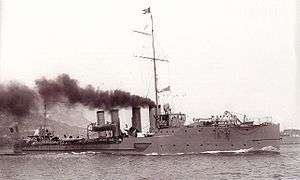French destroyer Bouclier
 Bouclier underway | |
| History | |
|---|---|
| Name: | Bouclier |
| Namesake: | Shield |
| Builder: | Chantiers et Ateliers Augustin Normand, Le Havre |
| Laid down: | 1909 |
| Launched: | 29 June 1911 |
| Completed: | 1911 |
| Struck: | 15 February 1933 |
| General characteristics | |
| Class and type: | Bouclier-class destroyer |
| Displacement: | 732–809 t (720–796 long tons) |
| Length: | 72.32 m (237 ft 3 in) (o/a) |
| Beam: | 7.6–8 m (24 ft 11 in–26 ft 3 in) |
| Draft: | 2.9–3.3 m (9 ft 6 in–10 ft 10 in) |
| Installed power: |
|
| Propulsion: | 3 shafts; 3 Parsons Steam turbines |
| Speed: | 30 knots (56 km/h; 35 mph) |
| Range: | 1,200–1,600 nmi (2,200–3,000 km; 1,400–1,800 mi) at 12–14 knots (22–26 km/h; 14–16 mph) |
| Complement: | 80–83 |
| Armament: |
|
Bouclier was the name ship of her class of destroyers built for the French Navy in the first decade of the 20th century.
On 27 June 1922, Bouclier collided with the battleship Paris at Toulon, France. Both ships suffered severe damage.[1]
Bouclier was stricken on 15 February 1933.
References
- ↑ "Casualty reports". The Times (43069). London. 28 June 1922. col E, p. 21.
Bibliography
- Couhat, Jean Labayle (1974). French Warships of World War I. London: Ian Allen. ISBN 0-7110-0445-5.
- Gardiner, Robert & Gray, Randal (1985). Conway's All The World's Fighting Ships 1906–1921. London: Conway Maritime Press. ISBN 0-85177-245-5.
This article is issued from Wikipedia - version of the 8/24/2016. The text is available under the Creative Commons Attribution/Share Alike but additional terms may apply for the media files.